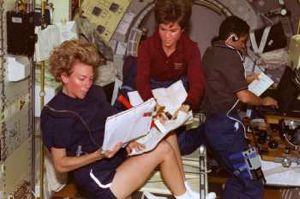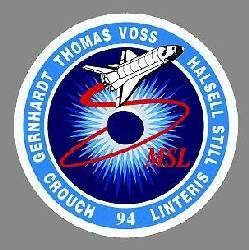
Home - Search - Browse - Alphabetic Index: 0- 1- 2- 3- 4- 5- 6- 7- 8- 9
A- B- C- D- E- F- G- H- I- J- K- L- M- N- O- P- Q- R- S- T- U- V- W- X- Y- Z
STS-94
 STS-94 |
AKA: Columbia;MSL-1R. Launched: 1997-07-01. Returned: 1997-07-17. Number crew: 7 . Duration: 15.70 days.
STS-94 was the reflight, with the same equipment and crew, of the curtailed STS-83 mission. Cargo Bay Payloads:
- MSL-1: The Microgravity Science Laboratory included the first test of the International Space Station's EXPRESS Rack. MSL-1 also contained numerous other experiment payloads to test materials and combustion processes in zero gravity.
- CRYOFD: The Cryogenic Flexible Diode (CRYOFD) heat pipe was a Hitchhiker payload.
- OARE: The Orbital Acceleration Research Experiment was a self-calibrating instrument that monitored extremely small accelerations and vibrations experienced during orbit of the Shuttle.
The mission this time went for its full two week duration and the crew completed the full list of experiments. The deorbit burn was on July 17, 1997 at 09:44 GMT and Columbia landed on KSC's Runway 33 at 10:46:34 GMT.
Following a modified processing session at Kennedy Space Center, Columbia lifted off a little late (because of some clouds downrange), at 18:02:02 GMT. The RSRM-62 solid rocket motors separated at 18:04 GMT. The ET-86 external tank separated at 18:11:13 GMT leaving Columbia in an elliptical transfer orbit which was circularized later by the OMS engines to a 296 x 301 km orbit inclined at 28.5 deg to the equator.
Development Test Objectives / Detailed Supplementary Objectives / Risk Mitigation Experiments
- DTO 255: Wraparound DAP Flight Test Verification
- DTO 312: External Tank TPS Performance
- DTO 416: Water Spray Boiler Quick Restart Capability
- DTO 667: Portable In-Flight Landing Operations Trainer
- DTO 677: Evaluation of Microbial Capture Device in Microgravity
- DTO 684: Radiation Measurement in Crew Compartment
- DTO 805: Crosswind Landing Performance
- DSO 331: Integration of the Space Shuttle Launch and Entry Suit
- DSO 487: Immunological Assessment of Crewmembers
- DSO 493: Monitoring Latent Virus Reactivation and Shedding in Astronauts
- RME 1330: Wireless Data Acquisition System
Payload And Vehicle Weights: Orbiter (Columbia) empty and 3 SSME's: 85,114 kg; Shuttle System at SRB Ignition: 2,051,646 kg; Orbiter Weight at Landing with Cargo: 117,806 kg; MSL-1 Spacelab Module: 10,169 kg; CRYOFD: 346 kg; OARE: 114 kg.
NASA Official Mission Summary:
STS-94
(MSL-1 reflight)
Columbia
Pad A
85th Shuttle mission
23rd flight OV-102
STS-83 reflight 38th
KSC landing
Crew:
James D. Halsell Jr., Commander (4th Shuttle flight, including STS-83)
Susan L. Still, Pilot (2nd)
Janice Voss, Payload Commander (4th)
Michael L. Gernhardt, Mission Specialist (3rd)
Donald A. Thomas, Mission Specialist (4th)
Roger K. Crouch, Payload Specialist (2nd)
Gregory T. Linteris, Payload Specialist (2nd)
Orbiter Preps (move to):
OPF - April 9, 1997
VAB - June 4, 1997
Pad - June 11, 1997
Launch:
July 1, 1997, 2:02:00 p.m. EDT. Liftoff was delayed about 12 minutes because of unacceptable weather conditions in the launch area in the event a return-to-launch-site abort was necessary. The launch window originally was targeted to open at 2:37 p.m., July 1. On June 30, NASA managers decided to move it back 47 minutes to 1:50 p.m. to avoid forecasted afternoon thundershowers.
Landing:
July 17, 1997, 6:46:34 a.m. EDT, Runway 33, Kennedy Space Center, Fla. Rollout distance: 8,892 feet (2710 meters). Rollout time: 55 seconds. Mission duration: 15 days, 16 hours, 44 minutes, 34 seconds. Landed on revolution 251. Landing occurred on first opportunity.
Mission Highlights:
STS-94 marked the first reflight of same vehicle, crew and payloads, following shortened STS-83 mission in April due to indications of a fuel cell problem. Primary payload was the Microgravity Science Laboratory-1 (MSL-1). A quick turnaround in processing Columbia for the reflight was accomplished in part by the first reservicing of a primary payload, MSL-1, in the orbiter.
The crew maintained 24-hour/two-shift operations. Using the Spacelab module as a test-bed, MSL-1 tested some of the hardware, facilities and procedures that will be used on the International Space Station. The 33 investigations conducted also yielded new knowledge in the principal scientific fields of combustion, biotechnology and materials processing.
Combustion experiments resulted in the discovery of a new mechanism of flame extinction caused by radiation of soot, and in the ignition of the weakest flames (as low as one watt, or 1/50 the power of a birthday candle) ever burned in laboratory conditions in space or on Earth, as well as the longest burning flames in space (500 seconds). Although only 144 fires or combustion experiment runs were scheduled, more than 200 were completed. The combustion investigations provided valuable information for improved fire safety on future spacecraft and for development of cleaner, more efficient internal combustion engines.
Experiments processed in the Electromagnetic Containerless Processing Facility (TEMPUS) yielded the first measurements of specific heat and thermal expansion of glass-forming metallic alloys, and the highest temperature (a maximum of 2,000 degrees Centigrade) and largest undercooling (to 340 degrees C) ever achieved in space. These measurements are necessary for modeling industrial materials systems to manufacture new and better products.
The mission also produced progress in learning how to control and position liquid drops which could lead to improvements in chemical manufacturing, petroleum technology and the cosmetics and food industries.
More than 700 crystals of various proteins were grown during the 16-day mission. Since crystals grow larger and purer in space, this research will help scientists to better understand their structures and to design more effective drugs to treat such diseases as cancer, diabetes and AIDS.
Samples in the Large Isothermal Furnace were processed to study the diffusion of tracers, or impurities, in melted germanium, an element used as a semiconductor and alloying agent. This was the first time diffusion in semiconductors has been studied in space. The Astro/Plant Generic Bioprocessing Apparatus (AstroPGBA) studied the effect of microgravity on various plants, including a source of an antimalarial drug; another used in chemotherapy treatment of cancer; and a species widely used in the paper and lumber industries.
The Expedite the Processing of Experiments to Space Station (EXPRESS) Rack flew for the first time on MSL-1 (both the STS-83 and STS-94 missions) to demonstrate quick and easy installation of experiment and facility hardware on orbit. It will be used on the International Space Station.
The 25 primary experiments, four glovebox investigations and four accelerometer studies on MSL-1 were contributed by scientists from NASA, the European Space Agency, the German Space Agency and the National Space Development Agency of Japan. A record number of commands – more than 35,000 – were sent from Spacelab Mission Operations Control Center at Marshall Space Flight Center to MSL-1 experiments.
More at: STS-94.
Family: Manned spaceflight. People: Crouch, Gernhardt, Halsell, Kilrain, Linteris, Thomas, Voss, Janice. Country: USA. Spacecraft: Columbia. Projects: STS. Launch Sites: Cape Canaveral. Agency: NASA, NASA Houston.
 | STS-94 Credit: www.spacefacts.de |
1997 July 1 - . 18:02 GMT - . Launch Site: Cape Canaveral. Launch Complex: Cape Canaveral LC39A. Launch Platform: MLP1. LV Family: Shuttle. Launch Vehicle: Space Shuttle.
- STS-94 - .
Call Sign: Columbia. Crew: Crouch,
Gernhardt,
Halsell,
Kilrain,
Linteris,
Thomas,
Voss, Janice.
Payload: Columbia F23 / Spacelab LM Unit 1 / EDO. Mass: 115,900 kg (255,500 lb). Nation: USA.
Related Persons: Crouch,
Gernhardt,
Halsell,
Kilrain,
Linteris,
Thomas,
Voss, Janice.
Agency: NASA Houston.
Manufacturer: Bremen.
Program: STS.
Class: Manned.
Type: Manned spaceplane. Flight: STS-94.
Spacecraft Bus: Shuttle.
Spacecraft: Columbia.
Duration: 15.70 days. Decay Date: 1997-07-17 . USAF Sat Cat: 24849 . COSPAR: 1997-032A. Apogee: 300 km (180 mi). Perigee: 296 km (183 mi). Inclination: 28.50 deg. Period: 90.50 min.
STS-94 was the reflight, with the same equipment and crew, of the curtailed STS-83 mission. Cargo Bay Payloads:
- MSL-1: The Microgravity Science Laboratory included the first test of the International Space Station's EXPRESS Rack. MSL-1 also contained numerous other experiment payloads to test materials and combustion processes in zero gravity.
- CRYOFD: The Cryogenic Flexible Diode (CRYOFD) heat pipe was a Hitchhiker payload.
- OARE: The Orbital Acceleration Research Experiment was a self-calibrating instrument that monitored extremely small accelerations and vibrations experienced during orbit of the Shuttle.
The mission this time went for its full two week duration and the crew completed the full list of experiments. The deorbit burn was on July 17, 1997 at 09:44 GMT and Columbia landed on KSC's Runway 33 at 10:46:34 GMT.
1997 July 17 - .
- Landing of STS-94 - . Return Crew: Crouch, Gernhardt, Halsell, Kilrain, Linteris, Thomas, Voss, Janice. Nation: USA. Related Persons: Crouch, Gernhardt, Halsell, Kilrain, Linteris, Thomas, Voss, Janice. Program: STS. Flight: STS-94. STS-94 landed at 10:46 GMT. .
Back to top of page
Home - Search - Browse - Alphabetic Index: 0- 1- 2- 3- 4- 5- 6- 7- 8- 9
A- B- C- D- E- F- G- H- I- J- K- L- M- N- O- P- Q- R- S- T- U- V- W- X- Y- Z
© 1997-2019 Mark Wade - Contact
© / Conditions for Use